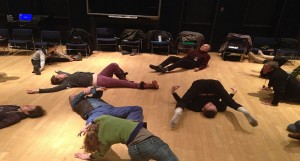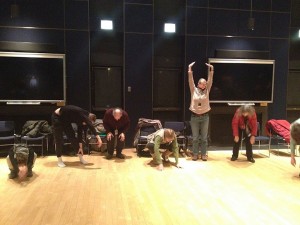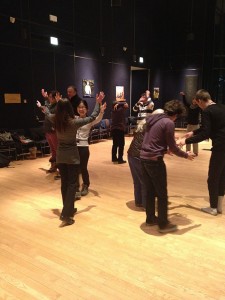UMS Night School: Curious About Dance – Session 2 Recap
Editor’s note: This post is a part of a series of by U-M student and UMS intern Hillary Kooistra, who’s covering our free UMS Night School: Curious About Dance workshop series.
It’s Just So…French
We might be facing sub-zero temperatures outside this week, but things were definitely heating up in the U-M Alumni Center on Monday night. We began our second Night School session with a stimulating conversation about Compagnie Non Nova’s Afternoon of a Foehn, then launched into a movement workshop led by newly Chicago-based solo contemporary artist Anna Martine Whitehead. Gestures played a key role in Monday’s session; in both our post-show reflection and Martine’s movement workshop, we found ways to make meaning through the creation, manipulation, and reimagination of repeated motions.
To begin the session, Clare reintroduced our Night School ritual: saying our names while performing a gesture. This time, as a way to kick off the conversation about Compagnie Non Nova, we recalled and produced gestures from the performance. Afternoon of a Foehn runs through next weekend, so those of us who have not yet seen it were instructed to amplify someone else’s gesture. The result? A highly creative game of movement telephone that had us moving in, out, and through our circle in response to one another’s memories of the performance.
We then shared the significance of the gestures we picked, and identified themes and concepts that stuck with us as we watched the performance. What makes a strong visual in performance? How do the rules established in performance alter our expectations of what is to come? How can the performance space change throughout the narrative, and how can it change us? These are only some of the questions that came up as we dissected our own interpretations of the captivating piece of experimental theatre (/dance/ballet/performance art…as we discussed, the category in which it falls is really up to interpretation).
We also landed on a discussion about the conventions of French performance, and how American audiences identify the work produced by European companies as well…European. The hierarchies of performers, sense of pride in claiming a space, and abstraction of narrative are some of the aspects we landed on as, to quote Clare, “just so…French.” For those who plan to head to Skyline High School this weekend, I’d be curious to hear if these concepts stick out to you as you watch the performance.
Warming up for a movement workshop by exploring negative space and interacting with others.
Our discussion of the many ways to approach and interpret Afternoon of a Foehn served as a perfect segway to Martine’s workshop, which centered around the choreographic approach of rethinking movement. She associated this process with Queer Dance, which offers alternative ways to think about gender and sexuality, critique the normal, and imagine other ways to be in the world. Martine will demonstrate this mode of thinking in this week’s performance of Confetti Sunrise, which features the work of Martine and four other queer artists. The workshop served to prepare us for this show, as well as for this weekend’s performance by the Trisha Brown Dance Company.
Throughout the half hour we spent stretching, speaking, moving, and listening, Martine invited us to think: How can gesture make meaning? How can we embellish it, and do it so much that it creates own score? She invited us to act on our instinct, focusing on the concepts of compulsion and desire.
Indulging in stretches during Anna Martine Whitehead’s movement session!
We ended the session in conversation with a partner, during which words were not the primary conversational agents. Responding to the prompt “tell me something that nobody knows,” we performed for our partners a series of gestures that they recalled and repeated back to us. We then manipulated the gestures that we grabbed from our partners (embellished, amplified, repeated, took to a different level…) and created a repeatable sequence–known in dance as a phrase. The exercise encouraged us to think about movement, maybe first as a substitute for words, but then as its own entity whose meaning might veer away from the choreographer’s original narrative.
My fantastic partner, Howard, tells me something that nobody knows using only gestures.
Howard recalls the gestures I conveyed to tell him something that nobody knows.
I was happy to think about this exercise not only from a Queer Dance perspective, but within the context of Trisha Brown. I interned for the company this past summer through UMS’s 21st Century Artist Internship Program, and I was lucky enough to take composition/improvisation classes with Associate Artistic Director Diane Madden while I was there. In class, Diane introduced to me Trisha’s choreographic method of “throwing and catching” movement: Trisha often performed gestures or longer series of movement for her dancers, then asked them to repeat them back to her without ruminating on what they saw. The dancers’ interpretations of her movements ultimately inspired much of her choreography. As I explored this process over the summer, I developed an awareness of how I interpreted movement and how my own movement resonated with others. I was excited to return to this way of working in Night School, and to draw ties between Trisha’s historic work and the innovative contemporary work of Queer Dance artists.
Silent conversations with partners–using gestures to convey meaning.
Speaking of Trisha Brown, we have quite the marathon of dance ahead of us in Ann Arbor this week! Compagnie Non Nova, Confetti Sunrise, Trisha Brown, Dance on Camera…we can have a quadruple bill if we really want to! Remember, if you go to more than one performance this weekend, you are eligible for double stars on your UMS Card. More stars, more dance, more fun.
Next Monday, we will be joined by U-M Associate Professor of Dance Amy Chavasse for our discussion of Confetti Sunrise and Trisha Brown. Then we get to raise a cupcake to Clare in celebration of her new book! She and Jim will be in conversation about Dancers as Diplomats: American Choreography in Cultural Exchange for the latter half of our session, so come hungry for treats and lots of dance talk! (Photocopies of Clare’s first two chapters can be found in our Night School folders, if anyone wants to complete a little pre-reading.)
Events This Weekend:
- Compagnie Non Nova, Afternoon of a Foehn, Feb. 14-21, various times, Skyline High School. TICKET REQUIRED
- Confetti Sunrise, Feb. 18-19, 7:30pm, U-M Duderstadt Center, Video Studio (FREE BUT LIMITED SEATING, FIRST COME FIRST SERVE)
- Dance on Camera Festival, Feb. 21-22, 6pm, U-M Museum of Art, FREE
- Trisha Brown Dance Company Performances, Feb. 21-22, 8pm, Power Center. TICKET REQUIRED
- Related Events:
- Feb. 21: You Can Dance: Trisha Brown Dance Company, Ann Arbor YMCA, 10:45am-12:15pm (SIGN-UP REQUIRED, BEGINS AT 10AM, FIRST COME FIRST SERVE)
- Feb. 21: Tune In: Trisha Brown Dance Company, Power Center Lobby, 7:30-7:45pm (TICKET REQUIRED)
- Feb 21: Opening Night Q&A: Trisha Brown Dance Company, Power Center, post-performance (TICKET REQUIRED)
- Related Events:
Session 2 Resources and Readings:
Dancers as Diplomats by Clare Croft
Introduction
Chapter 2
Artist Interview: Jamie Scott, Trisha Brown Dance Company Dancer
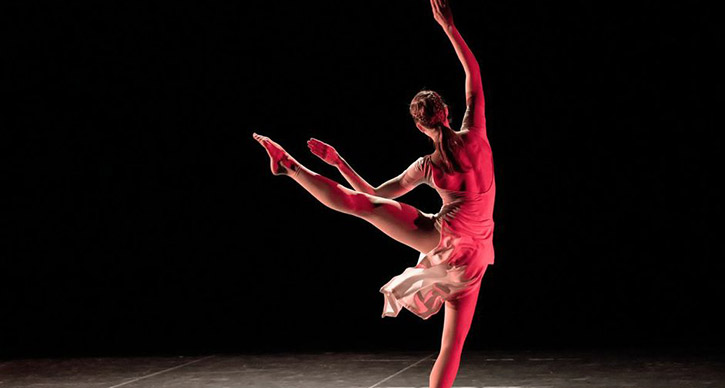
Photo: Trisha Brown Dance Company dancer Jamie Scott performs “If You Couldn’t See Me.” Photo by Alice Gebura.
The Trisha Brown Dance Company performs in Ann Arbor on February 21-22, 2015. Hillary Kooistra, University of Michigan Dance student and UMS intern, spent five weeks with the company during Summer 2014 as part of a new internship program. During her internship, Hillary had the chance to work with the company, and also to sit down with company members and interview them.
Her first was with dancer Jamie Scott. Jamie started dancing with the company as an apprentice in February 2012.
Hillary Kooistra: You’ve actually performed at UMS before with the iconic Merce Cunningham Dance Company. How has your work with the Trisha Brown Dance Company (TBDC) compared to your experience with Merce Cunningham?
Jamie Scott: It’s a very different way of approaching movement for me. A lot of the work that I’ve been doing since I joined TBDC has been re-calibrating the way that I think about movement, the way that I see movement, and the values that I give to different types of movement. There are many similarities, too, with learning repertory that’s been done before and with finding a way to re-inhabit works that have been done.
HK: Aesthetically, what would you say are some of the differences between Trisha’s work and Merce’s work?
JS: They strike a very similar aesthetic or taste from my point of view. But I’d say the biggest difference is that Merce’s work is very externally driven. The movement is very inorganic, and the task is finding a way to do the impossible, to use your muscles and everything you have to make these tasks possible. With Trisha, it’s almost the opposite. There are equally impossible tasks, but I’m trying to strip away as much as I can and re-calibrate force and energy. To find a way to arrive at the impossible form the inside out, rather than the outside in.
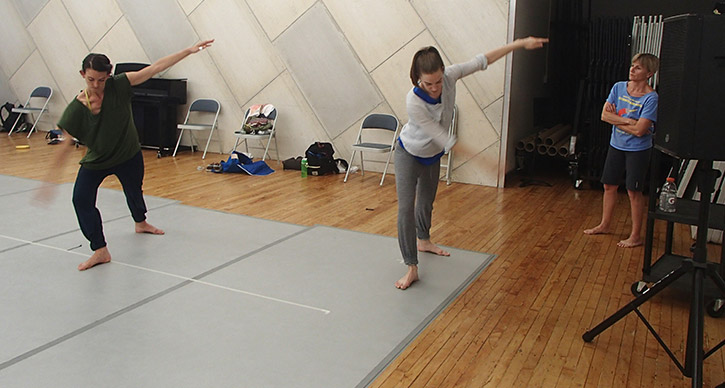
Photo: Jamie and Cecily Campbell (who shares the soloist role in “If You Couldn’t See Me”) rehearse part of the solo with Associate Artistic Director Diane Madden. Photo by Hillary Kooistra.
HK: At Power Center, you’ll perform Trisha Brown’s solo “If You Couldn’t See Me.” I know that you didn’t get to work directly with Trisha Brown in the studio, so how did you prepare, learn, and embody her movement for this solo?
JS: Leah Morrison, another dancer who has performed this solo, taught it to me along with Carolyn Lucas, one of the associate artistic directors of the company. After Leah left the company, we sat down with this amazing archive of footage of Trisha when she was first making the solo. In the video, she is going through the process of creating the movement, just so, and then taking it a step further, and then paring it back. We kind of went along with her whole process, and in doing that we got a lot of physical information that then translated into what you’ll see on the stage.
HK: I’ve noticed that the company often rehearses without music. When you do put on the music, what is that extra layer like?
JS: Actually, working with Merce Cunningham was similar in that respect. We never rehearsed to music, so I’ve gotten used to that. It’s sort of on and off, on and off. But I remember that the first time that I performed to music after rehearsing in silence, it added another dimension in the space. It opened up my awareness, my perception of the space, and gave me something else to interact with. Very tangible, actually. Oddly enough, it seemed very tangible.
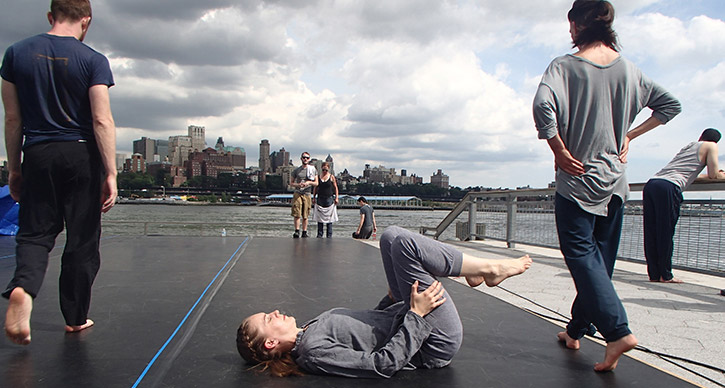
Photo: Jamie warms up before the Company’s performance of “I’m Going to Toss my Arms–If You Catch Them They’re Yours” at Pier 15 for the 2014 River To River Festival in New York City. Photo by Hillary Kooistra.
HK: What would you say is the most challenging aspect of Trisha Brown’s work?
JS: I would say that it’s being honest with movement and not embellishing, not exaggerating, but trusting the simplicity of it.
HK: Trisha’s known as one of the most iconic post-modern dancers and choreographers of our time, partially because of that quality of her movement vocabulary. Do you think that this term “post-modern” accurately characterizes her work?
JS: If we’re talking about stripping away the fluff, which is one of the big tenets of post-modernism in dance, really getting back to the human and getting rid of the fluff, this work continues to do that. This work is all about that, especially the earlier programs. The later work begins to explore, and as with any great artist, the trajectory goes somewhere else.
Read more of Hillary Kooistra’s behind-the-scenes coverage of Trisha Brown Dance Company.
Artist Interview: Leah Ives, Trisha Brown Dance Company Dancer
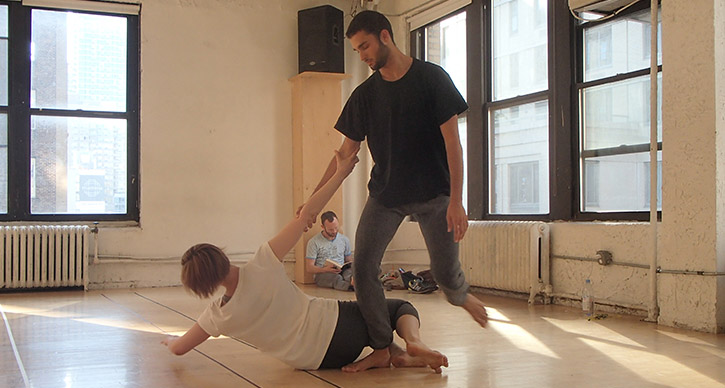
Photo: Trisha Brown Dance Company dancer Leah Ives and fellow dancer Marc Crousillat rehearse a duet from one of many pieces of repertory the two must learn as new members of the Company. Photo by Hillary Kooistra.
The Trisha Brown Dance Company performs in Ann Arbor on February 21-22, 2015. Hillary Kooistra, University of Michigan Dance student and UMS intern, spent five weeks with the company during Summer 2014 as part of a new internship program. During her internship, Hillary had the chance to work with the company on the administrative side and to also sit down with company members and interview them.
Her second interview was with dancer Leah Ives. Leah started dancing with the company in June 2014, and she is also a U-M Dance graduate.
Hillary Kooistra: You’re one of the newer members of the company. Trisha Brown Dance Company is an iconic post-modern company that’s currently in a transition period, and this performance is part of a tour that showcases major stage works. What’s it like to enter rehearsals when the company is in a transition period?
Leah Ives: It’s hard for me to know what it was like for people to enter when the company was not in a transition period. I think we’re very focused on the performances that are coming up, and so in some ways, I imagine that the transition hasn’t fully affected the company quite yet. I feel lucky to be able to jump in and have the chance to perform these works.
I also recognize that this movement hasn’t had as much time to settle into my body and that I have a lot to learn when compared to the other dancers who may have performed these roles and who have had years with these movements and with the pieces settling onto them. I feel like I have a large task to complete in a very short period of time.
HK: Did you always know that you wanted to dance for Trisha Brown?
LI: I was always interested in the company. Once I studied the movement and the repertoire, I found it really satisfying and intriguing mentally. There is a lot of specificity, a lot of attention to detail, and then a lot of of abandoning of that and seeing where that goes in the body.
So yes, I was always interested in the company, but there’s a point when a dancer recognizes that she’s one of many that would love to work for a full-time company, and an iconic company like Trisha Brown Dance Company at that. So, I was content studying the work and getting what I could from the work as a technique, as movement. I am so thrilled to be one of the lucky people who get to actually perform the work.
HK: What are you most excited to share with our Ann Arbor audience? I know the company is doing “Newark” as well as “Set and Reset” (1983).
LI: I’m excited to show the sense of weight and peacefulness in the body that Trisha Brown’s movement is known for. The sort of physics that play through the body in her work may be very different from some of the work that has been presented recently at UMS. I think the pieces we’re performing are really dynamic works, really exciting works, very full of bodies, movement, and interplay between dancers. They’re very exciting pieces to watch.
HK: You graduated from the University of Michigan with a BFA in Dance in 2007. Can you think of work that you did as an undergraduate student at U-M that reminds you of the work you’re currently doing?
LI: While I was there, choreographer Alexandra Beller set a piece with us, and both the interaction between dancers and the grounded-ness of the movement was similar to Trisha Brown’s work. Choreographer Doug Varone also set a piece with us, and the sense of momentum in that piece was very similar to Trisha Brown’s work, the sense of feeling the weight of the arms and the swing through the body. I had also studied with former Trisha Brown Dance Company dancers during the summers and that has really helped me in performing these works.
HK: How is Trisha Browns’s work differed from other dance works that you’ve encountered in your career so far?
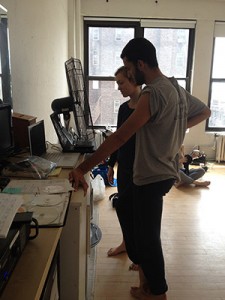
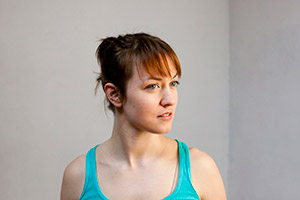
Photos: On left, Leah and fellow dancer Marc Crousillat review choreography from a DVD during some downtime in rehearsal. Photo by Hillary Kooistra. On right, Leah Ives. Photo courtesy of the artist.
LI: Trisha’s work is incredibly intricate in a way that I’ve not encountered very often. It’s very visual, the spacing between dancers is incredibly important. Trisha seemed to have a clear vision of what she wanted in each moment, so we are always trying to re-create that vision.
It’s a tricky process because we are looking at one version of that vision from when the work was originally created, and then maybe another version from ten years later and on a different stage and with different people. This process is very different from what I’ve done in the past.; my other projects have mostly been new works. This concept of taking these roles that were created by someone else and were modified through her body, put onto another body that may or may not have affected the role, and then taught to the person who is now teaching me, is a really interesting way of translating movement. It’s a great challenge. I’m not quite there in the rehearsal process yet.
HK: We’re really looking forward to seeing you on stage back in Ann Arbor! Before we end our chat, can you tell us about your most memorable UMS experience while you were at the University?
LI: The most memorable is hard to pick. I was fortunate enough to live fairly close to Ann Arbor growing up. I lived in Brighton, Michigan. So when I was in Middle School, we had a field trip to the Power Center to see Elizabeth Streb’s Dance Company. That was my first experience with modern dance. It was really exciting, especially at that age, to see people flying through space and their use of trampolines and technology (the soundtrack was based on the bouncing). That stuck with me for a long time.
Another experience that stuck with me was during the Royal Shakespeare Company residency. There were many programs beyond their performances, one of which included a competition of interpretations of a sonnet. I had made a dance based on a sonnet and got to perform it for Patrick Stewart. And I didn’t place, but it’s still something I can brag about! It was a great brag-worthy experience.
Read more of Hillary Kooistra’s behind-the-scenes coverage of Trisha Brown Dance Company.


